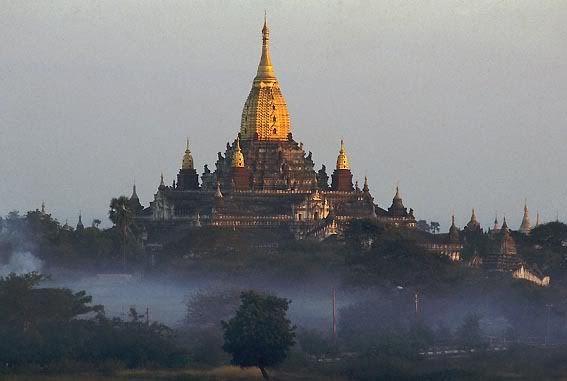This temple symbolizes the endless wisdom (Ananta Panna) of the Buddha just as the Thatbyinnyu temple symbolizes the omniscience of the Tathagata. Hence the name Ananta, which changed later to Ananda, the name of Buddha’s cousin.
The gilded htee (umbrella) caps the whole at a height of 168 feet above the ground. The interior consists of two vaulted and high but narrow corridors running parallel to each other along the four sides of the temple. They are connected by low and narrow passages in front of the window by which light is admitted and further intersected by four large corridors into which access is obtained through the porticoes.
In the center is an enormous cube, on the four sides of which are deep and high niches enshrining four colossal standing Buddhas of the present world who have appeared and entered Nirvana. The images are represented in the following order: north-Kakusanda; east-Konagamana; south- Kassapa; and west- Gotama. Each of them is 31 feet high above the throne, which itself is nearly 8 feet in height. Of these images only those on the north and south are the original ones contemporary with the foundation of the temple ; those on the east and west were put up later to replace the original images which were destroyed by fire.
Other Interesting features of the temple are the numerous glazed terracotta tiles (left page top) ornamenting the base and the receding terraces which represent the Jataka stories and the hosts of Mara’s army. Each of these plaques is inscribed with a Mon legend. The interior walls are honey-combed with niches in which are set small stone Buddhas in various postures. The most notable among the sculptures is a series of eighty relief’s in the two lower tiers of niches in the outer corridor, illustrating the life of the Bodhisattva from his birth to the attainment of supreme wisdom. The western sanctum also enshrines the life-size statues of its founder, Kyanzittha and the primate, Shin Arahan

